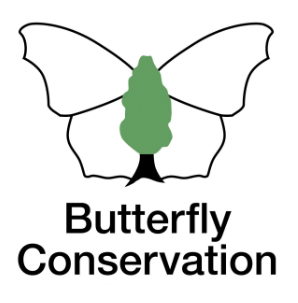Brown Argus
Brown Hairstreak
Chalkhill Blue
Clouded Yellow
Comma
Common Blue
Dark Green Fritillary
Dingy Skipper
Essex Skipper
Gatekeeper
Green Hairstreak
Green-veined White
Grizzled Skipper
Holly Blue
Large Skipper
Large White
Marbled White
Meadow Brown
Orange-tip
Painted Lady
Peacock
Purple Emperor
Purple Hairstreak
Red Admiral
Ringlet
Silver-washed Fritillary
Small Blue
Small Copper
Small Heath
Small Skipper
Small Tortoiseshell
Small White
Speckled Wood
Wall
White Admiral
White-letter Hairstreak
Extinct/rare immigrants
Silver-washed Fritillary
Argynnis paphia
General Distribution and Status
The Silver-washed Fritillary is our largest fritillary found in woodlands in the southern half of England and Wales with scattered colonies elsewhere, including Lancashire and Norfolk. Its strongholds are in the West Country where local populations can sometimes still be quite large. Like the other woodland fritillaries the butterfly declined in the 20th century and accelerated since the 1950s especially in the northern and eastern fringes of its range but it was usually the last to leave a wood (Heath et al.) due to its tolerance to shadier conditions. The cessation of regular woodland coppicing and general woodland management eventually meant that clearings where the larval foodplant used to thrive were too overgrown for the butterfly to survive. However, recent decades have seen a resurgence of this species probably aided by warm summers in the mid 1990s, for example, and the insect has now regained many of its former haunts. Since the 1970s the range has significantly expanded and abundance on monitored sites has more than doubled (Brereton et al., Fox et al.). The expansion in range led to the butterfly spreading into Hertfordshire at the beginning of this century with the largest impact in the hot summer of 2006 when the butterfly was also seen in Middlesex. It is now well distributed in Hertfordshire and expanding its range in Middlesex (Wood, 2019).
| United Kingdom | Herts & Middx | |||
| Distribution | 1976-2019 | +1% | 1980-2015 | +700% |
| Average 10-year trend | +0.3% | 2006-2015 | +19% | |
| 2024 since 2015-19 | -36% | |||
| Abundance | 1976-2024 | +230% | 1980-2015 | n/a |
| 2015-2024 | -44% | 2006-2015 | +2234% | |
| 2023-2024 | -60% | 2024 since 2015-19 | -56% | |
UK distribution map
UKBMS Species summary
Habitat Requirements
This species favours woodland clearings and rides with males more likely to be seen in the more open areas. Females on the other hand prefer shadier places to lay her eggs into crevices on a tree trunk, usually of oak, close to where there are clumps of Common Dog-violet Viola riviniana.
Larval Foodplants
Common Dog-violet Viola riviniana.
Adult Food Sources
Thistle Cirsium sp. (121), Bramble Rubus fruticosis (101), Buddleia Buddleja davidii (40).
Historical Records
Herbert Matthews referred to it as 'sometimes very common' in the woods around Stevenage in around 1900 (Gibbs) but by the 1930s it was not common (Foster). They were still seen in the Knebworth woods area in the 1940s; 10 were captured in July 1946 by Roger Ferry including one of the valezina form. The butterfly was quite numerous in St. John's Wood, Box Wood and High Wood in the same decade (Birdsall). However, since then numbers were declining - even more than the High Brown Fritillary and was probably extinct by 1980 in the county (Waterton). The last record in the Stevenage area before the recent expansion was in 1950 on 9 July in Knebworth Woods (Bowden).
Local Distribution and Abundance
As shown on the map, the Silver-washed Fritillary is more frequently found in the south-western part of the Stevenage area, especially the Knebworth Woods complex. The first record was from The Node, north of Codicote on 15 July 1997 but the next was not received until August 2004 when several were seen at the Knebworth Woods complex plus one surprisingly at Frogmore Gravel Pit. I found one in Whomerley Wood and Canyon Field (as it was then known) on 29 July 2006 and another was seen at Great Ashby Park on 8 August in the same year. Don Gregory saw a specimen at Astonbury Wood on 3 July 2007. Since 2009, it has regularly been seen around Watery Grove with the best year in 2013 when it was common. Records have been received from Great Ashby Park in four of the last six years. More than 20 reports were submitted each year since 2017 (by far the highest on record), mostly owing to increased recorder effort through transects and the Wider Countryside Butterfly Survey. Abundance have dropped slightly since 2019 but first-ever known reports arrived in the far north of our area for TL22E (Wymondley Woods in 2020) and TL22U (Weston village in 2021). The butterfly was slightly less common in 2023 although the highest ever count of 17 was recorded on 10 July in the Knebworth Woods complex during a Wider Countryside Butterfly Survey. A further drop in numbers in 2024 made it the worst year since 2015 with only 14 reports of 19 individuals in total.

Stevenage (South Fairlands Valley Park) transect 1993-2025
Before 2019, there are only four reports for the butterfly on the transect; the two as noted above on 29 July 2006, the third and fourth at the eastern end of Whomerley Wood on 8 August 2013 and 1 July 2018. Since 2019, however, sightings were found in the southern end of Whomerley Wood and eastern edge of Monk's Wood, six in 2019, eight in 2020 and five in 2022. In addition, a male and a female were spotted on the same day in August 2019 raising hopes that the butterfly is breeding here. On 29 July 2020, the valezina form was spotted on the southern end of Whomerley Wood.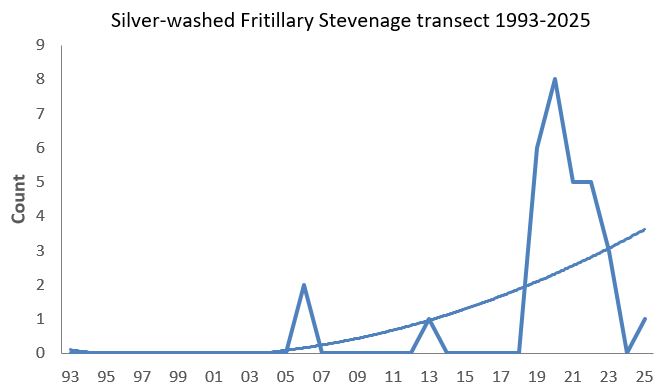
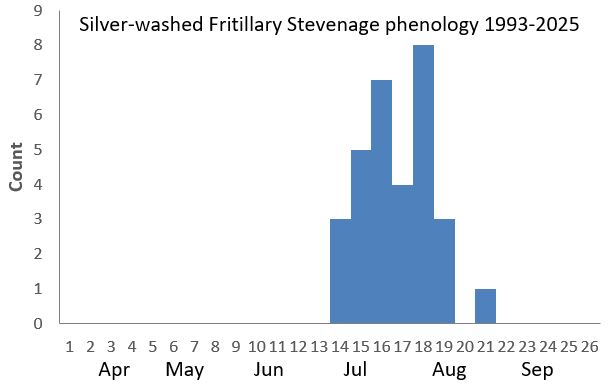
Knebworth Park transect 1996-2010 and 2017-2025
No Silver-washed Fritillaries were reported during the 1996-2010 period. Since 2017 at least one has been seen each year but not in 2023 nor 2024, with more than half being found in or north of Graffidge Wood.Knebworth Woods transect 2017-2025
Fairly common with most specimens seen in the Firs and Norton Green Common later in the season. Numbers have dropped since 2021.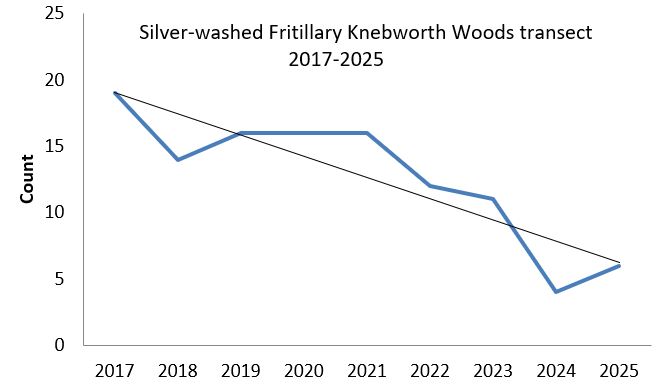
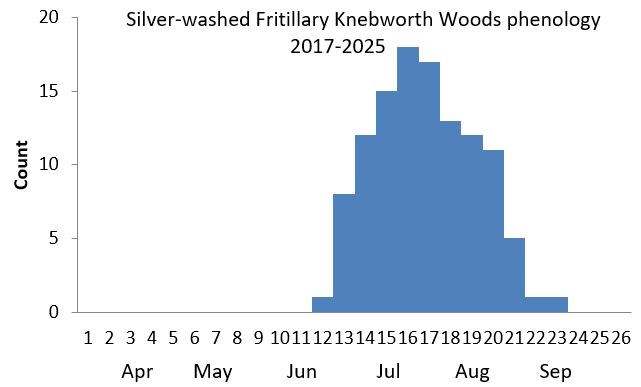
Pryor's Wood transect 2000-2022
No records submitted for this species although site is close to Great Ashby Park.Life History
Earliest date: 17 June 2014 near Pigeonswick Cottage
Latest date: 2 September 2013 at Norton Green Common
The Silver-washed
Fritillary is a single-brooded butterfly emerging from late June until the end of August. Males emerge about two weeks earlier than the females. Females lay
eggs in the crevices of a tree bark often facing north 1 to 2 metres above ground. The eggs hatch out in August. The larva eats the eggshell then spends the
winter on the tree trunk. In the spring, the larva descends the tree trunk and searches for the foodplants on which to feed. Pupae lay suspended under a
leaf or on a twig.
Behaviour/Observation notes
Both sexes are usually very active with their graceful and gliding flight and are easy to detect. Males establish territories in woodland clearings and are attracted to any orange object (Riley). Try placing some orange peel on a suitable substrate or surface.
Variations/Aberrations
It is thought that about 5% of females in a sizeable population will be of the form valezina where the ground colour of the wings is
replaced by olive-green. This form is well-known to butterfly lovers and used to be very common in the New Forest but has been recorded much further north
including Hertfordshire where it was reported in the 1940s in the Walkern area and Knebworth Woods as noted above. Stefan Hunt saw one on 23 July 2011
at the south end of Norton Green Common and we both found it again at the same spot a day later. What was noticeable was the change in its behaviour
- sluggish flight and preference for shade! This form was seen on 29 July 2020 on my Stevenage transect as noted above but as populations are very
low (never more than three on any visit) perhaps the 5% ratio of females being of this form is an under-estimate at this site!
Find out more on the UK Butterflies website
References
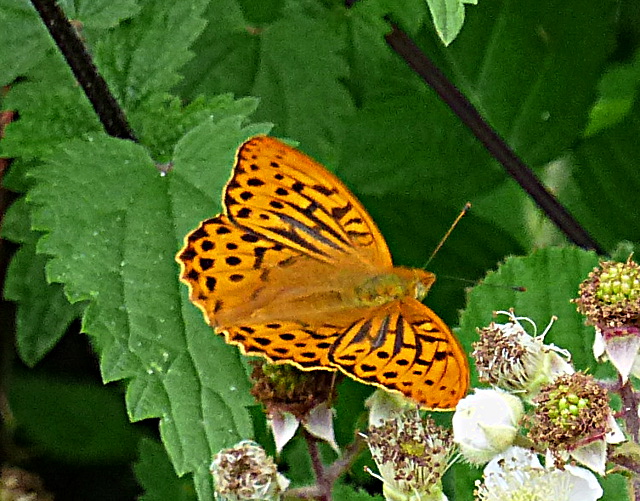
Cannocks Wood 14 Jul 2016 (m)
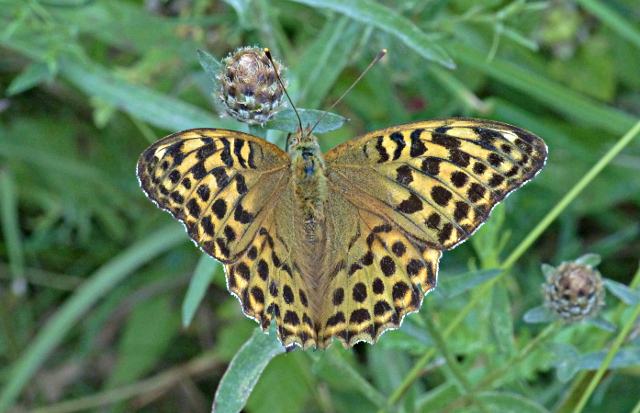
Watery Grove 23 Jul 2017 (f)
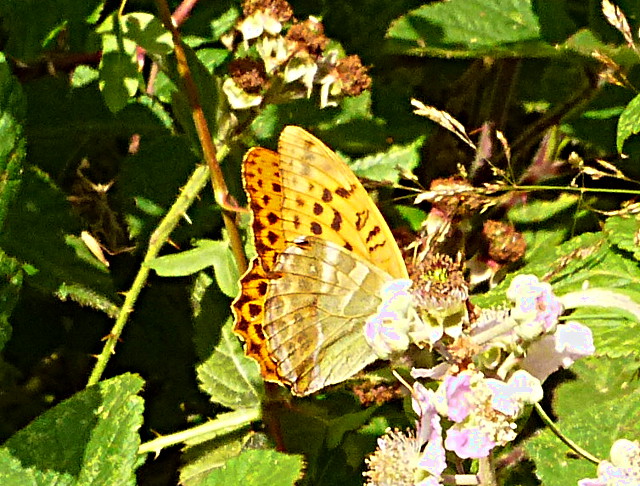
Hatfield Forest 25 Jul 2016 (m)
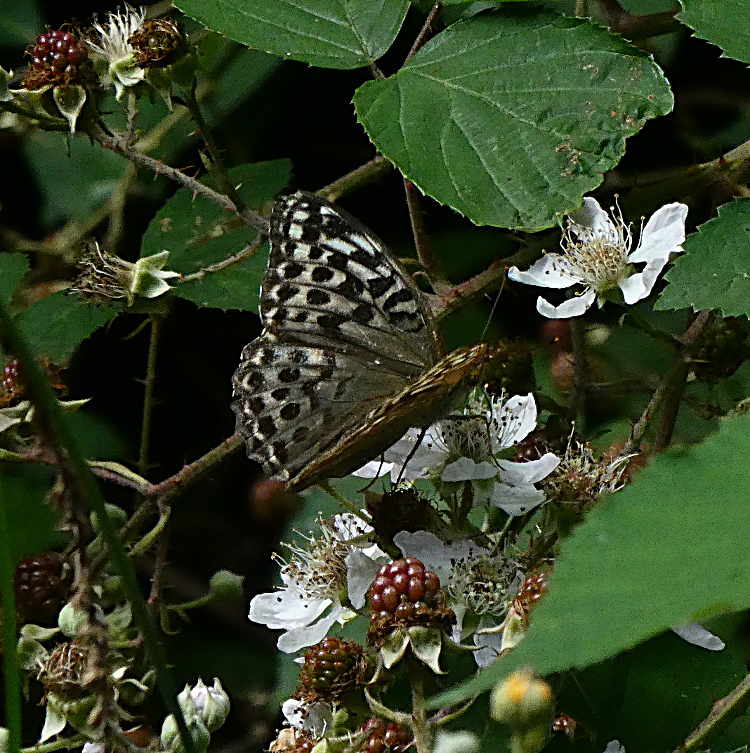
valezina Whomerley Wood 29 Jul 2020
